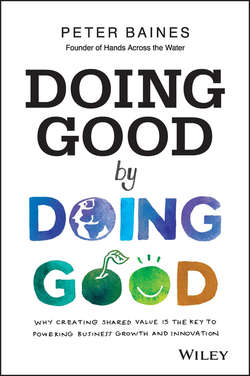Читать книгу Doing Good By Doing Good - Baines Peter, Peter Baines - Страница 8
Introduction
Clarity comes with action
The message
ОглавлениеWhat I hope that those working within the corporate or business world will take from this book is the idea that there is another way of interacting with society. It's not wrong for your business to benefit from the interaction; in fact, it's a damned sight better for all involved if you do benefit commercially from your activities in this space. The position that Unilever Global has taken on business growth and sustainable activities is ‘out there’, to say the least. It has attached its sustainability goals to the remuneration packages of its senior management team. Now there is a company that is driving its stake firmly into the ground.
There are a couple of shifts I see that are needed to move from the old paradigm of giving without any real expectation of return, other than publicity as a good corporate citizen, to the new paradigm of integrating shared value into the business. The first is the recognition that real benefits do exist and it can drive new business opportunities. The second, and probably most important for Australians, is being okay with saying, ‘I want to make money out of our social venture’. When those words can be spoken without drawing gasps or looks of disbelief around the room, we are on the way.
The message in this book for the charity and NFP is accepting there is another way of doing things. If you don't accept change you won't grow, and you are likely to see your effectiveness and influence diminish over time.
Many charities, particularly those that have been around for some time, either have accepted the need to change and continued to evolve in their operations, with their funding attached to the provision of services, or are watching their market share of the charity dollar slip further and further. For charities to grow or even survive in such a competitive marketplace they need to do things differently. This means not simply asking for money. Dan Pallotta, a charity founder and someone with strong views on how charities should spend their dollars, believes that people actually want to contribute and reach their full potential. And the traditional support of charities through the donation of a portion of people's income is not coming close to tapping the potential.
For charities to grow or even survive in such a competitive marketplace they need to do things differently.
I spend a lot of my time in front of other charities of small to medium size who want to know how we at Hands have successfully captured our share of the marketplace. Usually my advice can be simplified to these points:
• Create an experience to bring your supporters closer to what you are doing.
• Ensure you tell the story of what you are doing and the difference you are making, and inspire them sufficiently to want to tell your story.
• Help your corporate partners to find a way to maximise their investment in your charity.
It should go without saying – but I'll say it anyway – that if a charity already has the heart, mind and wallet of a supporter, it will stand to benefit if that supporter can improve their business through the relationship. If charity leaders are better educated about why business would want to engage with them and how their partners can profit from the experience, then the power in the relationship will shift towards one of equal footing. Rather than sending off your founder or chief fundraiser to ask for more, like a grown-up Oliver Twist, enable your charity leaders to bring value to the table. A lot of the lessons in this book are not rocket science; in fact, none are based on science on any level at all. Rather, they are based on the concept of shared value and looking to create mutually beneficial relationships. The book will provide the charity leader with a road map for helping their partners to find rewards in the way they give and to measure their returns.
Charity boards seldom have the same pressure to perform as a commercial board does. The shareholders of a company have skin in the game, they have a voice and they have a vote. They expect the directors on the board to perform and bring them a return, or they are out the door. The expectations on a charity board, while not insignificant, are different and generally less onerous. They are seldom held to account in the way a commercial board is. What comes with this greater tolerance is a level of complacency, an acceptance of the status quo and a resistance to change. As US writer Seth Godin puts it, ‘If you are not upsetting people, you are not bringing about change’.
Charities need to challenge the status quo, they need to provide value on both sides of the equation – for those they are supporting and for those who are funding them.
Too often directors on charity boards lack the necessary level of competence, or hold their positions well beyond their use-by date. The boards of charities need to be challenged in their expectations that people will donate because they have in the past or that they should get services for nothing because they are a charity, ignoring the well-known truism that ‘you get what you pay for’. Charities need to challenge the status quo, they need to provide value on both sides of the equation – for those they are supporting and for those who are funding them. There needs to be an enhanced level of shared value for sustainable growth.
